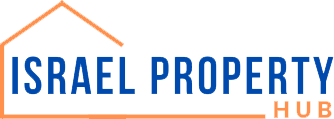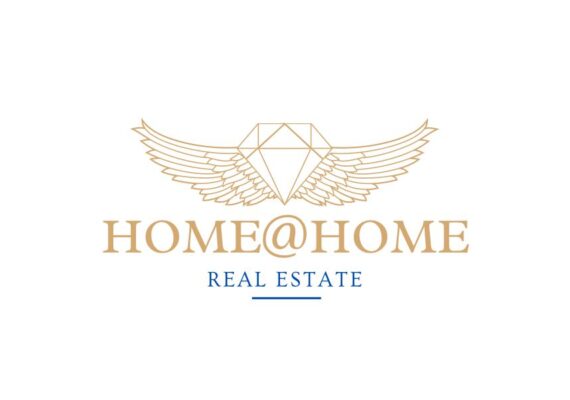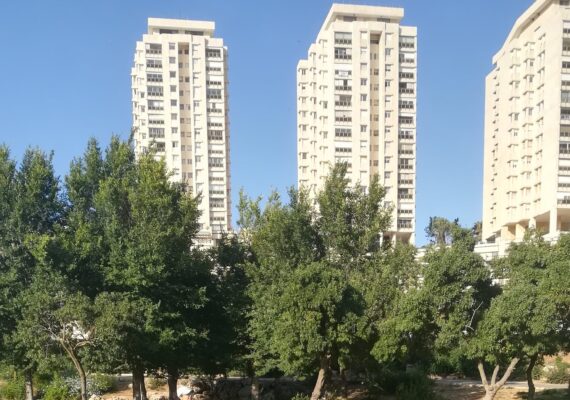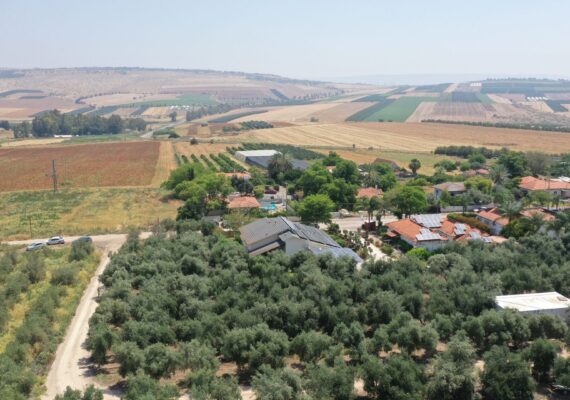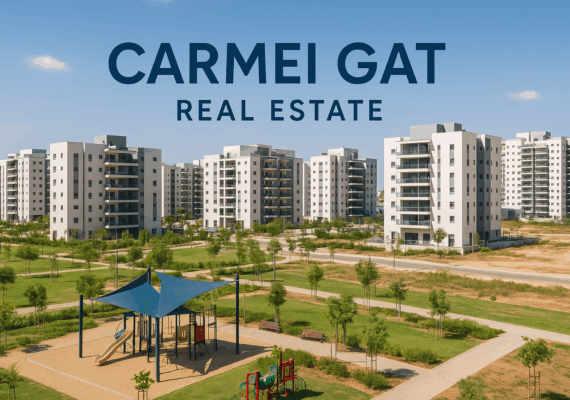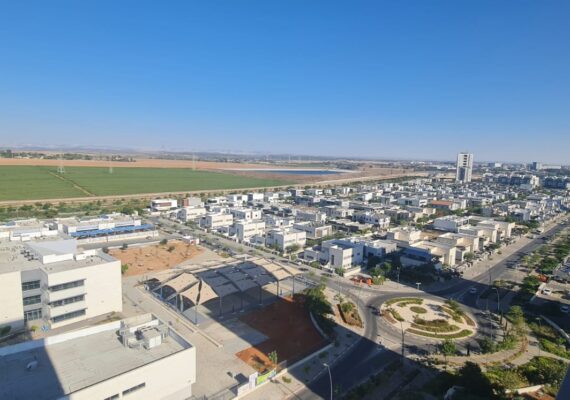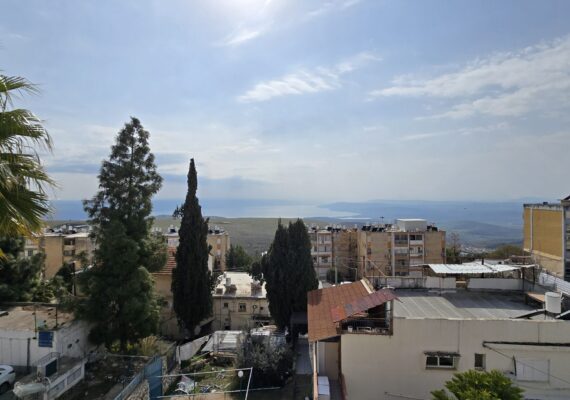Looking to explore Jerusalem? Each neighborhood tells its own unique story. Here’s what makes each area special:
🏛️ Abu Tor
Abu Tor is founded in the mid-1800s on a hill only a few hundred yards east of the Old City and the Kotel. Abu Tor’s hills provide dramatic views of Mount Zion and the Old City, with some of the most beautiful Jerusalem real estate found on tree-lined streets and paths. This unique neighborhood offers authentic Jerusalem living with historic charm and stunning panoramic views, making it one of the most scenic residential areas in the city.
🏔️ Armon Hanetziv
Armon HaNetziv is a quiet neighborhood on the outskirts of Jerusalem with commanding views of the surrounding areas, yet inexpensive relative to more centrally-located neighborhoods. It is still possible to acquire properties with stunning views for slightly more than NIS 1,000,000. The neighborhood is home to the famous Armon Hanatziv Promenade, one of Jerusalem’s best observation points offering panoramic views of the Old City and surrounding areas. If you are looking for an affordable apartment, you should look in this neighbourhood.
🏞️ Arnona
Located in southern Jerusalem, Arnona is a well-established residential neighborhood offering a mix of older apartment buildings and newer developments. The neighborhood attracts families and professionals seeking affordable housing options with good access to southern Jerusalem’s commercial areas and amenities. Arnona provides a suburban feel within the city while maintaining good connectivity to other parts of Jerusalem.
🍃 Baka
Originally a German Templar colony established in 1877, Baka transformed into a sought-after neighborhood combining old-world charm with modern amenities. The area features original Templar houses alongside new developments, trendy cafes, and restaurants. It’s particularly popular with English-speaking immigrants and young families due to its community feel and good schools.
🏡 Bayit VeGan
Today, Bayit VeGan is one of the most religious neighborhoods in Jerusalem, housing devout communities and many yeshivas and seminaries for men and women. Several institutions for overseas students dedicated to Torah study are located in Bayit VeGan. The upscale neighborhood also houses the prestigious Shaare Zedek Medical Center at its entrance. The area has seen growing demand for real estate, with spacious homes and new apartment buildings catering to large families, strong community atmosphere, and access to amenities like Malha Mall.
🏢 East Talpiot
Built after 1967 as one of the first neighborhoods constructed following the Six Day War, East Talpiot is located in southern Jerusalem. This residential area offers a mix of apartment buildings and some single-family homes, popular with families seeking affordable housing options. The neighborhood provides good access to the city center and features local shops, schools, and community facilities.
🎨 Ein Karem
This picturesque village-like neighborhood in Jerusalem’s southwest, Ein Karem features narrow cobblestone streets, stone houses with red tile roofs, and numerous artists’ studios and galleries. The neighborhood is home to several important churches, making it a significant pilgrimage site while maintaining its bohemian artistic atmosphere.
🏫 French Hill
Established after 1967 as one of the first post-Six Day War neighborhoods, French Hill is strategically located in northern Jerusalem near Hebrew University’s Mount Scopus campus. The neighborhood primarily consists of student housing and family apartments, offering easy access to the university and city center. French Hill is characterized by its academic atmosphere, diverse population of students and young professionals, and serves as a major transportation hub connecting northern and central Jerusalem. Bordering on Ramat Eshkot, French hill is gaining popularity among young religous English speakig familes.
🏛️ Geula
Geula is a neighborhood in the center of Jerusalem, populated mainly by Haredi Jews. Geula is bordered by Zikhron Moshe and Mekor Baruch on the west, the Bukharim neighborhood on the north, Mea Shearim on the east and the Jerusalem city center on the south. Geula was established in 1927–28. There are two Ultra-Orthodox neighborhoods in the center of Jerusalem – Geula and Mea Shearim, making Geula a significant hub for the Haredi community.
🌿 German Colony – Emek Refaim
Established in the second half of the 19th century as a German Templer Colony, this upscale neighborhood is bisected by the famous Emek Refaim Street. The street represents modern Jerusalem culture within historic German Templar style buildings, lined with restaurants, cafes, and boutique stores. This is Jerusalem’s most fashionable neighborhood, offering a perfect blend of European architecture and contemporary Israeli lifestyle just minutes from downtown.
🏔️ Gilo
Built after 1967 as one of the first neighborhoods constructed following the Six Day War, Gilo is located in southern Jerusalem and serves as a major residential area. The neighborhood offers stunning panoramic views of the Judean Hills and Bethlehem, featuring modern apartment buildings and well-planned infrastructure. Gilo is known for its family-friendly atmosphere, good schools, and shopping centers, making it popular with young families seeking affordable housing with scenic surroundings.
🏢 Har Homa
Added to Jerusalem’s neighborhoods in the 1990s, Har Homa is one of the city’s newest residential areas, located in southern Jerusalem. This modern neighborhood features contemporary apartment buildings, planned infrastructure, and family-friendly amenities. Har Homa offers affordable housing options with modern conveniences, attracting young families and professionals seeking new construction in a suburban setting.
🏛️ Katamon
Old Katamon attracts upper-middle class families and is popular amongst the English-speaking community in Jerusalem. The neighborhood is home to numerous schools and educational institutions, along with the famous shteiblach (small synagogues) that serve the religious community. San Simon and Katamonim are extensions of the original Katamon area, offering a vibrant community atmosphere with access to top-tier educational institutions, parks, cafes, and cultural centers. The blend of secular and religious communities contributes to the area’s dynamic social fabric.
🏘️ Kiryat Moshe
Kiryat Moshe is a neighborhood in Jerusalem, named for the British Jewish philanthropist Moses Montefiore. Founded in 1923 with funding from the Moses Montefiore Testimonial Fund in London. Due to its central location, Kiryat Moshe has become a sought-after neighborhood in Jerusalem for urban renewal and development projects. It is home to the famous Mercaz Harav Yeshiva and is centrally located close to Givat Shaul
🏘️ Kiryat Yovel
Kiryat HaYovel is a neighborhood in southwestern Jerusalem on Mount Herzl. It was built in the early 1950s to house Jewish refugees who fled the Arab world. Today, Kiryat HaYovel has a population of 25,000 residents. Kiryat HaYovel is located on the main road to Hadassah Hospital, Ein Kerem, between Ramat Denya and Kiryat Menachem. Kiryat HaYovel was established in 1952 to house thousands of Jews from Arab countries who fled their homes when the State of Israel was declared.
🏘️ Mea Shearim
It is one of the oldest Ashkenazi neighborhoods in Jerusalem outside of the Old City. It is populated by Ashkenazi Haredi Jews, and was built by members of the Old Yishuv. The neighborhood was first established in 1874 by a group of daring young pioneers from the Old City who wanted to build a new Jewish settlement outside the city walls—the fifth such settlement. The unique Jerusalem Haredi community lives according to traditional Jewish laws as their ancestors did in Eastern European villages a hundred years ago.
🌿 Mekor Haim
Named for Haim Cohen, a wealthy Jewish businessman who donated large sums toward land purchase in Jerusalem before World War I, Mekor Haim was established in 1926 by the religious Zionist Mizrahi movement as a village of 20 small farmsteads built along one main street. Located in southern Jerusalem, it’s surrounded by Baka to the east, Katamon to the west, the Greek Colony to the north and Talpiot to the south. Today, this quiet neighborhood maintains its historic character while offering modern amenities and good connectivity to nearby commercial areas. Mekor Haim is home to a large Anglo community and the famous Jerusalem Mekor Haim elementary schools.
🏛️ Musrara
Located between East and West Jerusalem, Musrara was built in the 1870s as an affluent Arab neighborhood and later became home to North African Jewish immigrants in the 1950s. Today it’s undergoing gentrification while maintaining its multicultural character. The neighborhood features beautiful 19th-century Ottoman architecture and is home to the Musrara School of Art, making it a cultural hub that bridges different communities.
🏘️ Nachlaot
One of Jerusalem’s oldest neighborhoods outside the Old City, Nachlaot is actually a collection of 23 small courtyards built in the 1870s-1880s. This vibrant area features narrow alleyways, colorful street art, and a mix of religious and secular residents. The neighborhood is known for its authentic Jerusalem character, affordable housing options, and proximity to Mahane Yehuda Market, making it popular with young professionals and artists.
🏢 Neve Yaakov
Built after 1967 as one of the first neighborhoods constructed following the Six Day War, Neve Yaakov is located in northern Jerusalem. This residential neighborhood offers affordable housing options for families, featuring modern apartment buildings, shopping centers, and religious institutions. The area is popular with religious families and provides urban residential living within Jerusalem’s municipal boundaries.
🏢 Pisgat Ze’ev
Pisgat Ze’ev has five distinct districts: Center (1984), West (1988), East and North (1990), and South (1998), situated in north Jerusalem. This large residential neighborhood offers affordable housing options for families, with modern apartment buildings, shopping centers, and schools. The area provides a suburban feel within Jerusalem, popular with religious and secular families alike seeking spacious living arrangements and community amenities.
🏡 Ramat Shlomo
Added to Jerusalem’s neighborhoods in the 1990s, Ramat Shlomo is located in northern Jerusalem. This residential neighborhood primarily serves the ultra-Orthodox community, featuring apartment buildings designed for large families, religious institutions, and kosher amenities. The area offers affordable housing options within a religious community setting.
🏘️ Ramot
Established as one of the first neighborhoods built after 1967, Ramot is one of Jerusalem’s largest residential areas, located in the northwest of the city. The neighborhood consists of multiple sections (Ramot Aleph, Bet, Gimmel, etc.) and offers diverse housing options from apartments to single-family homes. Ramot is known for its family-friendly environment, good schools, and shopping centers, making it popular with many religious families.
🌳 Rehavia
Established in the 1920s, Rehavia is Jerusalem’s most prestigious neighborhood, designed as a garden city with tree-lined streets and International Style architecture. It’s home to the President’s residence, the Prime Minister’s official residence, and numerous cultural institutions. The neighborhood attracts diplomats, academics, and professionals, offering quiet residential streets with easy access to the city center.
🏔️ Romema
Romema (Hebrew: רוממה, lit. Uplifted) is a neighbourhood in northwest Jerusalem, just off the Tel Aviv-Jerusalem highway at the main entrance to the city. It occupies the highest hill in Jerusalem. Romema is bordered by Kiryat Mattersdorf and Mekor Baruch. Its strategic location at the city’s main entrance makes it a gateway neighborhood with excellent transportation access. It is home to many ultra orthodox families
🏘️ Shmuel HaNavi
Shmuel HaNavi (“Samuel the Prophet neighborhood”) is a neighborhood in north-central Jerusalem. It is bordered by the Sanhedria Cemetery to the north, Maalot Dafna to the east, Arzei HaBira to the south, and the Bukharan Quarter to the west. It is named after Shmuel HaNavi (Samuel the Prophet) Street. As with the adjacent neighborhoods of Beit Yisroel, Meah Shearim, Geulah and Shmuel Hanavi, the residents are ultra-Orthodox.
🏺 Talbiye
Built in the 1920s-1930s as an affluent Arab neighborhood, Talbiye features stunning examples of eclectic architecture mixing European and Middle Eastern styles. After 1948, it became home to Israeli intellectuals and diplomats. The neighborhood boasts spacious stone houses with beautiful gardens, tree-lined streets, and is considered one of Jerusalem’s most elegant residential areas.
🌺 Yemin Moshe
Built in 1891 as the first Jewish neighborhood outside the Old City walls, Yemin Moshe was funded by British Jewish philanthropist Moses Montefiore. The neighborhood features distinctive windmill landmark, narrow stone houses, and offers spectacular views of the Old City. Today it’s one of Jerusalem’s most expensive and exclusive neighborhoods, popular with artists and professionals seeking historic charm.
